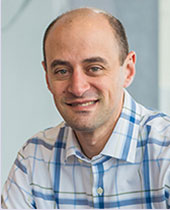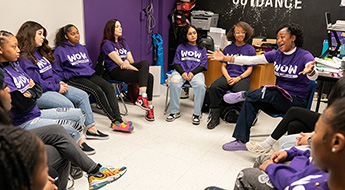Jonathan Guryan
Lawyer Taylor Professor of Education and Human Development
IPR Fellow and Chair of IPR’s Program on Education and Human Development
PhD, Economics, Massachusetts Institute of Technology, 2000
Economist Jonathan Guryan’s work spans various topics related to labor markets, education policy, and social interaction. His research interests include the causes and consequences of racial inequality, the development of skills and human capital in both early childhood and adolescence, the labor market for teachers, social interactions in the workplace, youth violence, and lottery gambling. In recent projects, he has investigated the effectiveness of an individualized, intensive math-instruction program, and the effectiveness of cognitive-behavioral therapy based interventions for at-risk youth.
Guryan is a research associate at the National Bureau of Economic Research. He also serves as a co-director of the Education Lab. His research has received support from the Smith Richardson Foundation, W. T. Grant Foundation, National Science Foundation, National Institute of Child Health and Human Development, and Institute for Education Sciences in the U.S. Department of Education. In 2009, he received the John T. Dunlop Outstanding Scholar Award from the Labor and Employment Relations Association. Before joining Northwestern, he was on the faculty of the University of Chicago’s Booth School of Business.
Current Research
SAGA Innovations: High-Intensity, Individualized Math Tutoring. Most attempts to improve academic outcomes for disadvantaged adolescents have yielded disappointing results. This has led some to argue that improving the academic outcomes of children in poverty is too difficult and costly once they reach adolescence. A recent study by Guryan and colleagues at the UChicago Education Lab has shown that this conclusion may be premature. Very few interventions have targeted a key barrier to school success: “mismatch” between what is being taught and the academic level of youth, particularly those far behind grade level. In partnership with SAGA Innovations and the Chicago Public Schools, Guryan and his Education Lab colleagues have shown that providing individualized, one-on-two math tutoring for an hour a day during the regular school day can substantially improve outcomes for youth. Students who participated in this tutoring program gained one to two additional years of math knowledge in a single year, equivalent to reducing the black-white achievement gap by roughly a third. This evidence has led Chicago and New York City to invest public resources to bring this promising intervention to thousands of young people in disadvantaged neighborhoods.
Reducing Violence and Increasing Graduation: The Becoming a Man Program. The majority of homicides in Chicago stem from altercations that turn into tragedies because someone overreacts to a provocation. Often the provocation seems quite minor, while the response seems very impulsive—almost automatic. How can we help youth avoid the kinds of automatic behavior that can be dangerous or deadly in some urban neighborhoods? Youth Guidance’s Becoming a Man (BAM) program has been highly effective in addressing the sort of impulsive, automatic responses that can lead to violence. BAM offers youth weekly group sessions during the school day and uses cognitive behavioral therapy to help youth slow down in high-stakes situations. In two randomized controlled trials, Guryan, along with several co-authors and colleagues at the UChicago Crime Lab, found that BAM cuts violent-crime arrests among youth in half and boosts the high school graduation rates of participants by nearly 20 percent. The program and this rigorous evidence of effectiveness were key inspirations for President Obama’s My Brother’s Keeper initiative aimed at improving the lives of young men of color, and Chicago policymakers and the Chicago Public Schools are now scaling BAM as part of the city’s violence reduction strategy.
Selected Publications
Bhatt, M., J. Guryan, H. Pollack, J. Castrejon, M. Clark, L. Delgado-Sanchez, P. Lin, M. Lubell, C. Pinto Poehls, B. Shaver, and M. Sumners. 2023. Randomized evaluation of a school-based, trauma-group intervention for you women in Chicago. Science Advances. 9(23): eabq2077.
Guryan, J., J. Ludwing, M. Bhatt, P. Cook, J. Davis, K. Dodge, G. Farkas, R. Fryer, S. Mayer, H. Pollack, L. Steinberg, and G. Stoddard. 2023. Not too late: Improving academic outcomes among adolescents. American Economic Review 113(3): 738–765.
Black, S,. S. Breining, D. Figlio, J. Guryan, K. Karbownik, H. Nielsen, J. Roth, and M. Simonsen. 2021. Sibling spillovers. Economic Journal 131(633): 101–28.
Guryan, J., S. Christenson, A. Cureton, I. Lai, J. Ludwig, C. Schwarz, E. Shirey, and M. Turner. 2021. The effect of mentoring on school attendance and academic outcomes: A randomized evaluation of the Check & Connect Program. Journal of Policy Analysis and Management 40(3): 841–82.
Heller, S., A. Shah, J. Guryan, J. Ludwig, S. Mullainathan, and H. Pollack. 2017. Thinking, fast and slow? Some field experiments to reduce crime and dropout in Chicago. Quarterly Journal of Economics 132(1): 1–54.
Figlio, D., J. Guryan, K. Karbownik, and J. Roth. 2016. Long-term cognitive and health outcomes of school-aged children who were born late-term vs full-term. JAMA Pediatrics 170(8): 758–64.
Figlio, D., J. Guryan, K. Karbownik, and J. Roth. 2014. The effects of poor neonatal health on children’s cognitive development? American Economic Review 104(12): 4205–30.
Filiz-Ozbay, E., J. Guryan, K. Hyndman, M. Kearney, and E. Ozbay. 2013. Do lottery payments induce savings behavior? Evidence from the lab. Journal of Public Economics 126: 1–24.
Guryan, J. and K. Charles. 2013. Taste-based or statistical discrimination: The economics of discrimination returns to its roots. Economic Journal 123(572): F417–F32.


